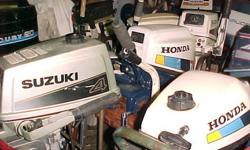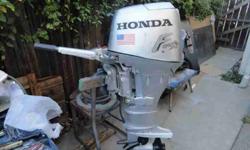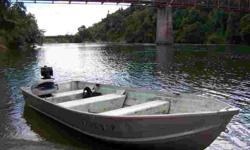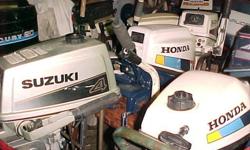We buy, sell, trade, tune-up, and repair all brands, years, sizes and lengths of outboard motors including Johnson, Evinrude, Mercury, Sears, Wards, Mariner, British Seagull, Elgin, Firestone, SeaKing, Gale, Clinton, Elgin, Wizard, Eska, Solo, Chrysler, Aero Marine, Gamefisher, Cruise'n Carry, Force, Scott, McCulloch, Ted Williams, Martin, Mighty Mite, Bumble Bee, Champion, and numerous others in addition to: Honda, Nissan, Suzuki, Tohatsu, Yamaha, Tanaka, Tas, Aquabug etc. (repairing vintage and antique outboards is our extra specialty). We also carry used propellers for many of the above brands and we have several electric trolling motors for sale. Turn-around time, for carry-ins is about 5 business days or less. A larger motor attached to your boat usually takes 1 to 2 days. We also rebuild electric starters and pull starters for all motors and we have a huge selection of used outboard motors for sale ranging from 1hp to 250hp. All our motors have been serviced and ready to go. We do remove and install large outboard motors of all sizes. Call Marty at [removed phone] to discuss your motor. If no answer, please leave a clear message and I will get back to you as soon as possible. Sometimes we can help you fix your problem on the phone at no cost. (Please no E-Mails or texts). When you bring it in, we will give your outboard motor a compression and spark test, diagnose your engine, and tell you what it needs in repairs to get it back in good running condition. We do not charge for this service. We will repair your motor at your request, answer your questions and make suggestions. Most of our business is by recommendation of satisfied customers. We will do everything possible to make you one. USEFUL TIPS & INFORMATION:(1) All 2 stroke outboard engines made after 1963 require a 50:1 mixture (3 ounces of 2 stroke outboard motor oil per gallon of gas). The actual amount is 2.6 ounces per gallon (a little extra won't hurt, but less can cause severe damage to your engine). NOTE: NEVER use 100:1 as recommended by some manufacturers. It will cause your engine to lose compression and die prematurely. The only lubrication that your engine gets is from the oil that is mixed with the gas, therefore use 50:1 to be safe. (2) Older outboards (pre 1963) require double the amount of oil 25:1 mixture (6 ounces per gallon), some require a 16:1 mixture (8 ounces per gallon), and BRITISH SEAGULL engines require a 10:1 mixture (13 ounces per gallon). (3) 4 stroke outboards do not need oil mixed with the gas. Make sure the crankcase is full of oil (check the dipstick). If by mistake you ran your 4 stroke with oil mixed with gas do not be concerned. It's OK. (4) Always carry a minimum amount of tools like screwdrivers (blade and Phillips head), socket set including a spark plug socket, combination wrenches, vice grips, pliers, fire extinguisher, drift or punch to drive out a broken shear pin, a can of WD - 40, and a spray can of carburetor cleaner for starting emergencies, and a few extra new spark plugs (pre gapped) in case yours become fouled, a new gas filter if your gas line has one, a tire pressure gauge, a long magnet and (extra-long) forceps (in case you drop a nut or a bolt), and a small flashlight. AVOID USING STARTER FLUID because it contains ether (bad for outboards). Also carry a pair of extra shear pins and cotter pins (for most outboards less than 35hp). And also a few small hose clamps to tighten a loose or leaking fuel line (see tip #53 below).(5) For small outboards under 40hp, keep the clamp handle screws greased so they will not freeze up from oxidation or salt.(6) For all outboards that have remote steering, grease the steering cable every time you go out in salt water to prevent the cable from "seizing up" and causing a costly repair.(7) For all outboards, starting it several times a year keeps everything "limber". (8) For all outboards, flushing your outboard in fresh water for 5 minutes after each saltwater use will prevent costly cooling system repairs. NOTE: Do not flush your motor in saltwater. Use a barrel, or a garden hose hooked up to outboard "earmuffs" or any other device made for your motor.(9) If you carry your small outboard motor in the bed of a pick-up truck, always tie it down securely or it might break the tiller or shift handle by rolling(10) For all outboards, check your propeller for broken blades or chunks missing from any blade. Operating any outboard with uneven prop blades will cause vibration and damage to seals and other internal parts of the lower unit. Also it is best to carry a spare prop. (Approx. cost $50 for a used one). (11) Spray a thin coat of WD 40 all around the powerhead of your outboard. It will not make your engine run better, but it will protect it from rust and salt deposits. (12) For pull start outboards, check the entire pull cord for signs of wear. You wouldn't want to break a pull cord when you are out fishing. (13) For electric start outboards, always carry 2 fully charged batteries. Sometimes your outboard charging system will fail to work and it may discharge the battery if it produces less than 12 volts. You can easily test it with a volt meter. Check the voltage at the battery before you start the engine and then afterwards while it is running. (The voltage before should be approx. 12 volts and voltage while running should be approx. 14 volts). If the voltage is not higher than 13 volts, your charging system is faulty. (14) For small (tiller steering) outboards up to 35hp, attach a short chain, cable or heavy rope (one end attached to your outboard's clamp section, and the other end attached to the transom of your boat) as a safety to prevent your motor from falling overboard. (15) For all outboards, in the event that you remove the top cowling to check your engine, put the cowling down away from the edge of the boat since any wave might send the cowling to the bottom of the ocean or lake. It will be difficult to locate a replacement. (16) For all outboards, always be aware of the heat of your engine by watching the temp. gauge (if you have one) or by watching the "pisser". Most engine failure is a result of overheating. Always check to see if steam is coming out with or without the water. If that happens, shut off the engine to avoid costly damage. Check the bottom of your engine to see if you picked up some vegetation, or a plastic bag which may be blocking your water intake. If you do not find anything, you might have a bad impeller or a bad water-pump housing. The best thing to do is, try (if possible) to get towed back by any good natured person in the area, or call "VESSEL ASSIST". If you do not have "Vessel Assist insurance", it will be quite costly. To avoid all of the above, it is best to change your impeller every 2 years or sooner. Whether you use your outboard frequently, occasionally, or just once in 2 years, it is time more than wear that ruins the impeller.














